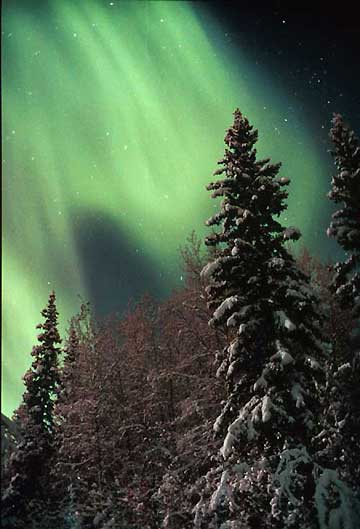 By Ned Rozell November 01, 2006
"I don't expect your website to continue to post the 'Auroral Forecast' (during the summer) just for Alaska Cab, but you may not be aware that some companies access this information for business purposes. For us, I monitor your website and a NOAA space weather site so that I will know if such things will be affecting our computer system communication between our office and the cabs in the city. " Sometimes the aurora messes with the radio waves used in communications systems. My employer, the Geophysical Institute, exists in a large part because of this. The institute is a place of more than 300 faculty, staff and students that the U.S. Congress established here in Fairbanks in 1946. Part of the reason for satisfying "the need for a geophysical station" at this high latitude was to understand more about the aurora, which sometimes disables high-frequency radios people use to communicate over long distances. How does the aurora disable radios? High-frequency radios can transmit signals thousands of miles by skipping them off the bottom of the ionosphere (part of Earth's atmosphere starting at about 50 miles over our heads, where the air is so thin it's electrically charged). The ionosphere, extending about 600 miles into space, is the home of the aurora. Active auroras disturb the ionosphere at the height of about 55 miles, causing it to absorb some radio waves rather than reflect them. Some auroras also act as a reflector, so radio signals can travel much farther than normal. A Fairbanks cab driver once received instructions from a dispatcher in New Jersey because of this phenomenon, researcher Bob Hunsucker wrote in this column in 1976. Aurora scientists here at the Geophysical Institute have been in the business of predicting aurora activity for the public on the Internet since 1995, but they were interested long before that. Syun-Ichi Akasofu, one of the world's experts on the aurora and now the director of the International Arctic Research Center, got the idea for predictions in the 1970s, when Air Force Colonel Lee Snyder, who worked on an over-the-horizon radar facility in Maine, called Akasofu with a problem: The northern lights were messing with the radar's ability to see large objects, such as approaching enemy bombers. If scientists could predict aurora activity, the Air Force could make plans for when the radar was useless. You can see today's aurora prediction by going to the Geophysical Institute's Web site at http://www.gedds.alaska.edu/AuroraForecast/. Deehr and fellow forecasters recently added two automatic forecasts that run all year, even when it's too light for northerners to see the aurora-a 28-day forecast and a more accurate one-hour forecast. Both should be useful for drivers of cabs in the Far North and others wishing to know times when the aurora might scramble their transmissions.
Publish A Letter on SitNews Read Letters/Opinions
|
||
